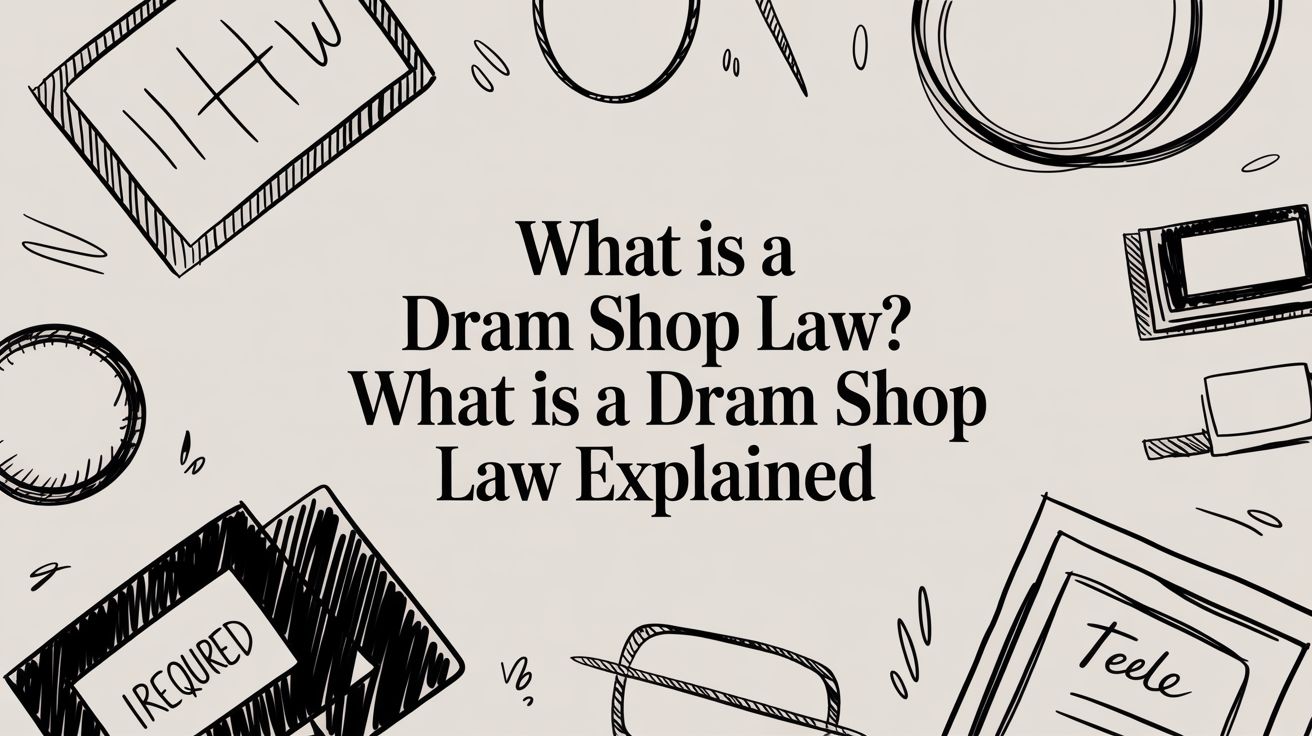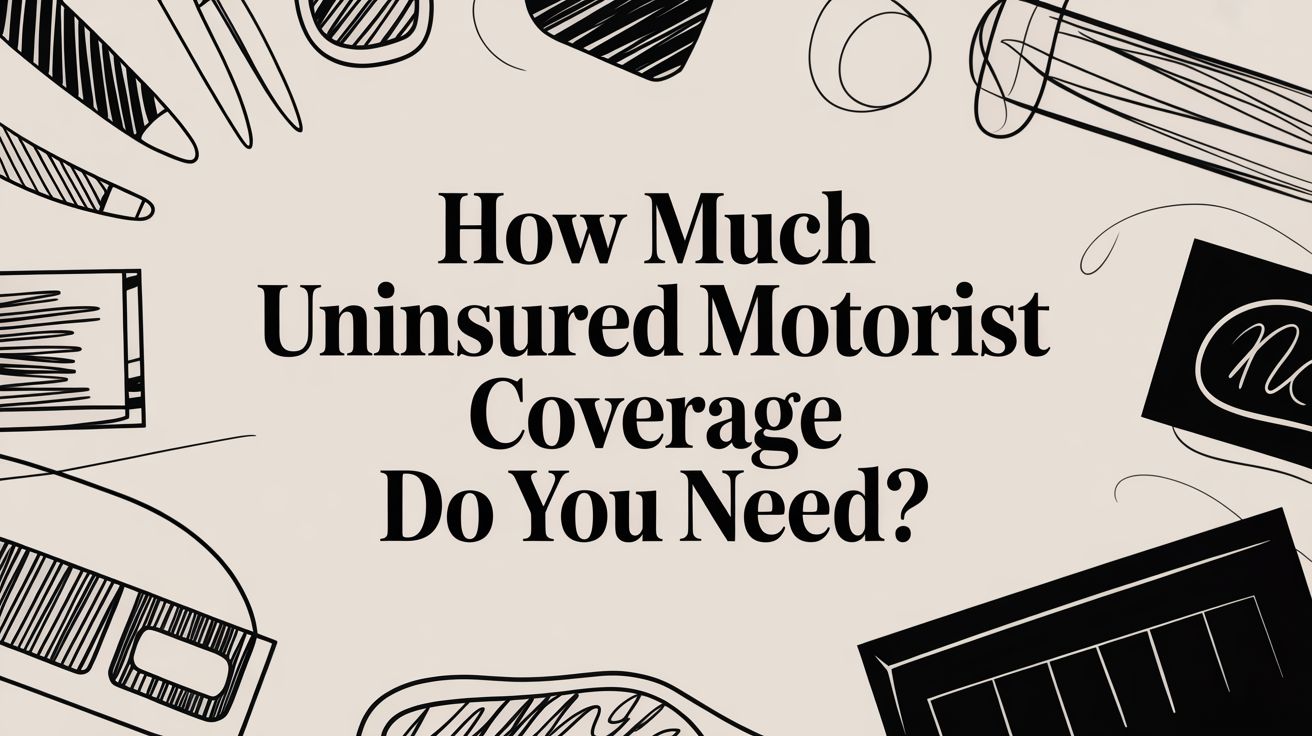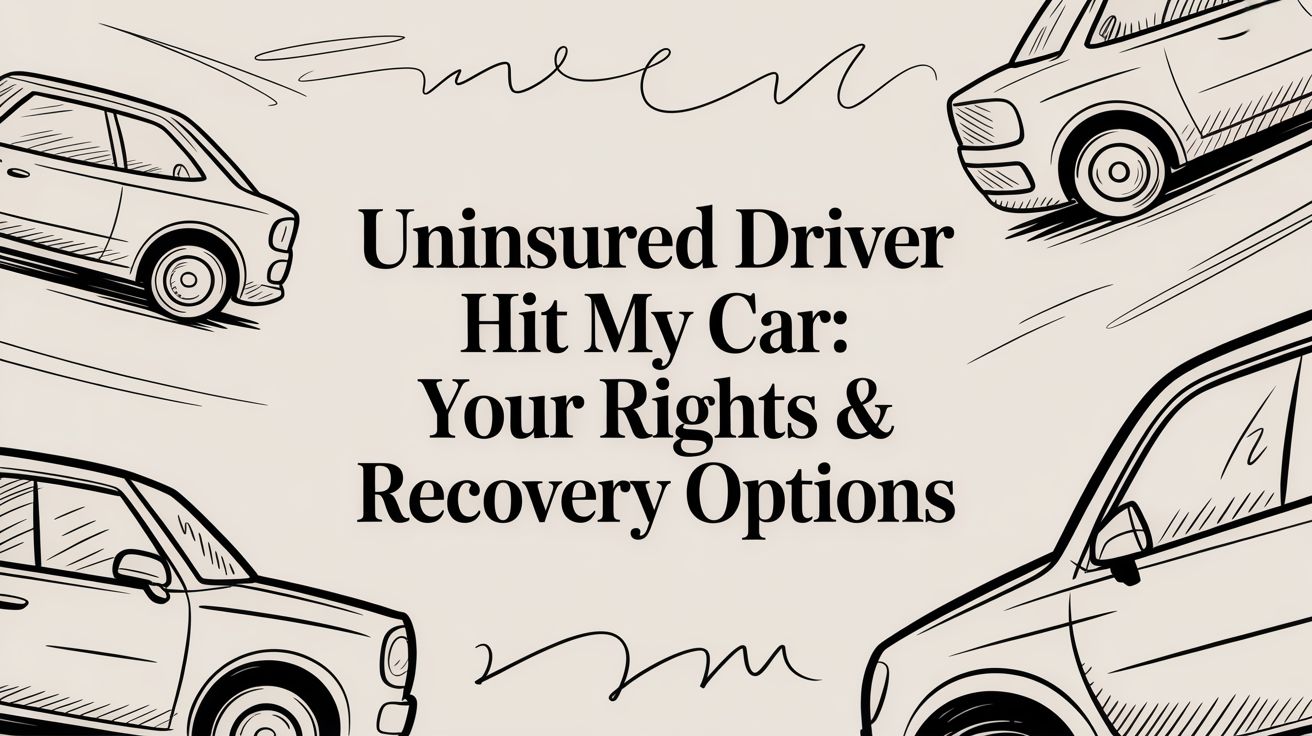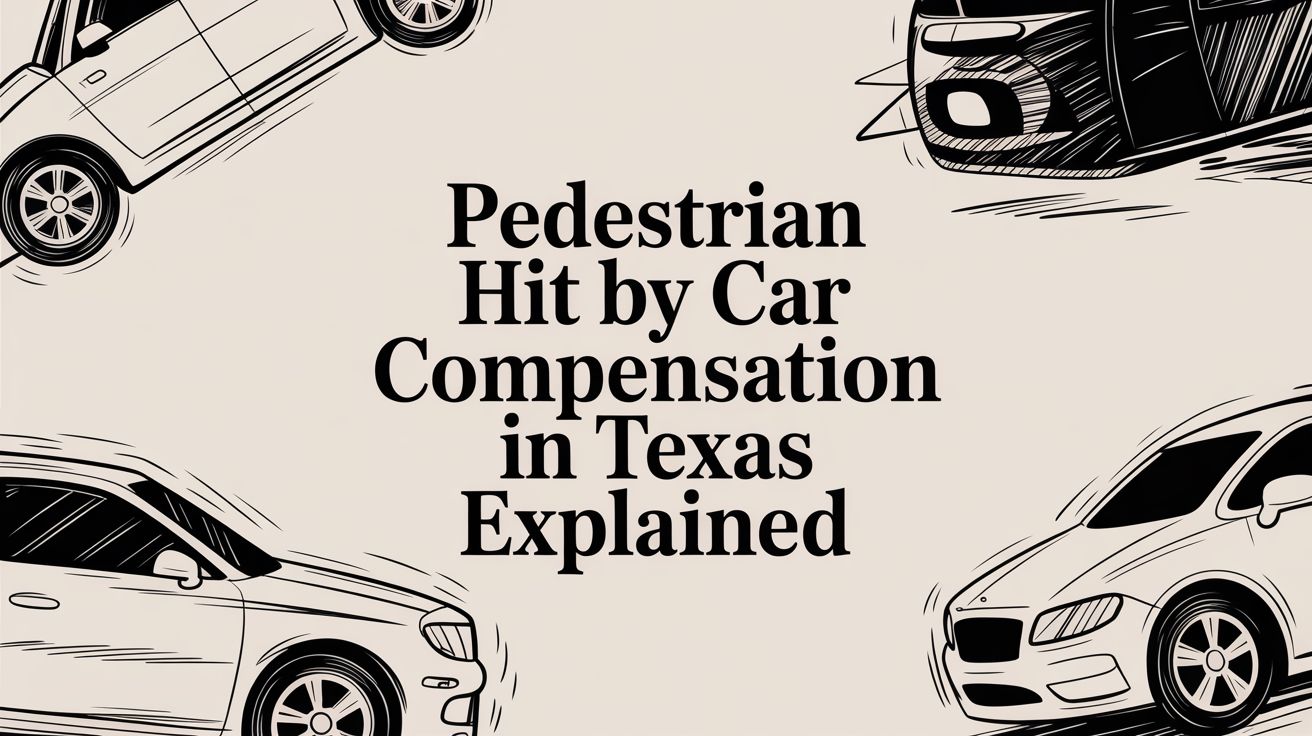A serious accident can change your life in seconds—but you don’t have to face it alone. After a crash, you are left with physical pain, emotional trauma, and a mountain of questions. One of the first is often, "What is a T-bone accident?" Simply put, it's a side-impact collision where the front of one car smashes into the side of another, creating a distinct 'T' shape.
These crashes are terrifyingly dangerous, and for one simple reason: the sides of a vehicle offer very little protection, leaving you and your passengers incredibly vulnerable.
The Reality of a T-Bone Accident
A T-bone, or side-impact, collision happens when the paths of two vehicles cross at the exact same moment, one hitting the other perpendicularly. The point of impact is usually the driver or passenger-side door, leaving the people inside with just a thin layer of metal and glass to absorb a massive, violent force.

Think about the front and back of your car. They have "crumple zones" designed to collapse and absorb energy in a head-on or rear-end collision. The sides have nothing like that. This critical structural weakness is exactly why T-bone accidents so often lead to severe, life-altering injuries.
To help you quickly grasp the key elements, here's a simple breakdown.
T-Bone Accident Quick Facts
Understanding the key characteristics of a side-impact collision.
| Characteristic | Description |
|---|---|
| Collision Type | Side-impact, where one vehicle's front hits another's side. |
| Shape | Forms a "T" at the point of impact. |
| Primary Location | Intersections with traffic lights or stop signs. |
| Main Cause | Failure to yield, running red lights, or unsafe left turns. |
| Key Danger | Lack of significant "crumple zones" on the vehicle's side. |
| Common Injuries | Head, neck, spinal, chest, and pelvic trauma. |
These facts highlight just how vulnerable you are in this type of crash.
Where and Why These Accidents Happen
The vast majority of T-bone accidents happen at intersections. It’s a scenario we’ve all seen or narrowly avoided: a driver runs a red light or a stop sign, or they try to make a left turn without yielding to oncoming traffic.
For example, after a Houston freeway crash, a family might be dealing with the consequences of a distracted driver. Picture a busy intersection during rush hour. A driver, distracted for just a second by a text message, blows through a red light and plows into the side of a car that was legally crossing the intersection. That single, brief mistake can have devastating consequences for the innocent person on the other side.
These collisions are far more common—and deadly—than many people realize. Side-impact crashes are responsible for nearly 25% of all passenger vehicle fatalities in the United States. That's a shockingly high figure, especially since they aren't the most frequent type of crash overall. In Texas alone, thousands of people were killed or seriously injured in intersection-related crashes between 2017 and 2021. You can find more details about these shocking numbers in this in-depth report on T-bone accidents.
Understanding how a side-impact crash works is the first step toward getting justice. If you or someone you love was hurt in this kind of wreck, it’s important to know that you have rights. A dedicated Texas personal injury lawyer can guide you on the path to recovery.
Why Side-Impact Crashes Cause Severe Injuries
The brutal truth about a T-bone accident is that it hits you where you're most vulnerable. Think about it: the front and back of your car are designed with crumple zones, structures built specifically to absorb and redirect the force of a crash. But the sides? They offer little more than a door and a window for protection.
This minimal buffer is exactly why side-impact collisions so often lead to devastating outcomes. There’s simply not enough metal and space to dissipate the energy before it reaches you and your passengers.

When another vehicle slams into the side of yours, the force transfers almost directly to the occupants. It’s an incredibly violent event, which is why these crashes are a leading cause of both catastrophic injuries and tragic wrongful deaths.
The Devastating Human Cost
Picture a family driving home from a soccer game on a busy Houston street. A distracted driver in a large truck blows through a red light and plows into their passenger side. The impact caves in the door, causing severe injuries to the mother in the passenger seat.
Suddenly, she's facing a long, painful recovery from a traumatic brain injury (TBI) and multiple fractures. She can't work. She can't care for her family like she used to. This single moment of negligence sends out ripples of overwhelming medical bills, lost income, and immense emotional distress.
Because the impact is so direct and violent, the resulting injuries are often life-altering.
Common Injuries in T-Bone Accidents
The types of injuries we see in these cases are a direct result of the mechanics of a side-impact collision—the sudden, violent sideways force that the human body isn't built to withstand.
| Injury Type | Affected Body Area | Common Causes in a T-Bone Crash |
|---|---|---|
| Traumatic Brain Injuries (TBIs) | Head and Brain | The violent side-to-side jerking motion causes the brain to slam against the inside of the skull. A direct hit to the head on the door or window is common. |
| Spinal Cord Injuries | Neck, Back, and Spine | The immense force can fracture vertebrae or damage the spinal cord, potentially leading to partial or complete paralysis. |
| Internal Organ Damage | Chest and Abdomen | The impact can crush the torso, leading to internal bleeding and severe damage to vital organs like the spleen, liver, kidneys, or lungs. |
| Pelvic and Hip Fractures | Pelvis, Hips, Legs | These are especially common for the person sitting closest to the point of impact, as the car's frame is pushed inward, crushing the lower body. |
| Neck and Shoulder Injuries | Neck, Shoulders, Back | Whiplash-type injuries are frequent as the head and neck are violently snapped from side to side, tearing muscles and ligaments. |
Given that nearly half of those injured in T-bone crashes suffer trauma to vital organs, and head injuries are the second most common injury type, the need for proper recovery is critical. Side-impact crashes often result in severe neck trauma, and for those seeking support, learning how to relieve neck pain naturally can be an essential part of the healing process.
If you want to discover more insights about these T-bone accident injuries, the data confirms just how dangerous these collisions are.
How Texas Law Determines Fault in a T-Bone Crash
After a traumatic T-bone accident, one of the biggest questions on your mind is probably, "Who is legally responsible for my injuries?" In Texas, the answer to that question is the bedrock of your personal injury claim. Our state uses a fault-based insurance system, which means the person who caused the crash is responsible for paying for the damage.
To hold the other driver accountable, you and your attorney must prove they were negligent. In legal terms, negligence simply means the other driver failed to act with reasonable care, and that failure is what caused your injuries.
For instance, if a driver on a busy San Antonio road blows through a red light and smashes into the side of your car, they clearly broke the law and were not acting with reasonable care. That action directly caused the crash and your injuries, which makes them negligent and, therefore, at fault.
Understanding Comparative Responsibility in Texas
Proving the other driver was negligent is the first big step, but Texas law also considers whether you might share any of the blame. This is handled by a legal rule called modified comparative responsibility, also known as the 51% bar rule. This rule is absolutely critical to understand because it directly impacts how much compensation you can recover.
Here’s a simple breakdown of how it works:
- You can recover damages as long as you are found to be 50% or less at fault for the wreck.
- Your compensation award will be reduced by your percentage of fault.
- If you are found to be 51% or more at fault, you are barred from recovering any compensation at all.
Insurance companies often try to shift as much blame as they can onto you, the victim. Their goal is to either reduce what they have to pay or deny your claim completely. This is exactly why having an experienced Houston car accident attorney or truck crash lawyer Houston fighting for you is so important.
A Real-World Example of Comparative Fault
Let's see how this plays out in a real-life situation. Imagine you were T-boned at a Houston intersection. It’s clear the other driver ran a stop sign. However, the insurance company claims your headlights weren't on at dusk, which made your car harder to see.
The case goes to a jury. After hearing all the evidence, they decide the other driver was 90% at fault for ignoring the stop sign, but they assign 10% of the fault to you because of the headlight issue. Let's say your total damages—for medical bills, lost paychecks, and pain and suffering—add up to $100,000.
Because you were found 10% at fault, your final award gets reduced by that amount. You would receive $90,000 instead of the full $100,000. This example shows why building a rock-solid case that pins the primary negligence on the other driver is absolutely essential for your financial recovery. An attorney's job is to gather the evidence needed to push back on the insurance company's claims, minimize any fault assigned to you, and fight for the maximum compensation you deserve.
Practical Steps to Take After a Collision
In the chaotic moments after a T-bone accident, it’s almost impossible to think clearly. Your head is spinning, you're trying to figure out what just happened, and the adrenaline is pumping. But the steps you take right then and there can make a huge difference for both your health and your legal rights down the road.
First things first: your health is the absolute top priority. Even if you think you just have a few bumps and bruises, seek medical attention right away. Side-impact crashes are notorious for causing injuries like internal bleeding or traumatic brain injuries that don't show symptoms immediately but can be life-threatening if ignored.
How to Handle Insurance Companies
Once you're safely out of traffic, your next job is to gather as much information as you can. If you're physically able, use your phone to document everything. Take pictures and videos of the damage to both cars from every angle, any skid marks on the pavement, the traffic lights, and any visible injuries.
You'll also want to make sure you:
- Call 911: This is non-negotiable. A police report creates an official record of the crash, which is a cornerstone of any future claim.
- Exchange Information: Get the other driver’s name, phone number, insurance policy details, and driver’s license number. Snap a picture of their documents to be safe.
- Talk to Witnesses: If anyone saw what happened, get their name and number. An independent account from a bystander can be incredibly powerful.
This infographic breaks down how Texas law views the process of determining fault and securing compensation for victims.
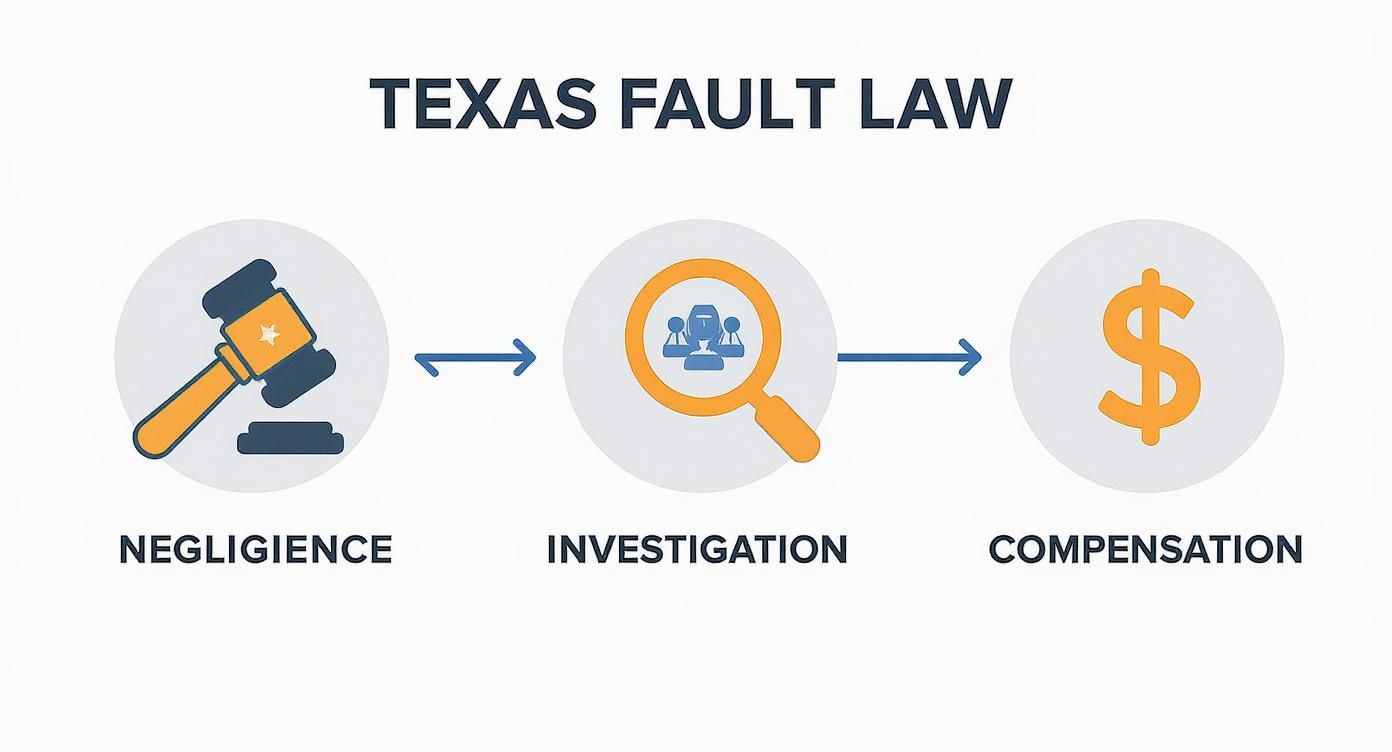
It all starts with proving negligence. From there, a full investigation builds the case that ultimately leads to compensation for everything you've lost.
It won’t be long before you get a call from the other driver’s insurance adjuster. It’s critical to be careful here. You can state the basic facts—where and when the accident happened—but do not give a recorded statement or say anything that sounds like you're accepting blame.
Insurance adjusters are trained professionals whose job is to pay out as little as possible. They know what to ask to get you to say something they can use against you later. Before you agree to anything, talk to a lawyer who knows their playbook. For a deeper dive, you can learn more about what to do after a Texas car accident on our blog. Letting an attorney handle these calls protects you from their tactics and lets you focus on what really matters: getting better.
How a Personal Injury Lawyer Builds Your Case
After a devastating T-bone accident, trying to figure out the legal side of things while you’re focused on healing can feel impossible. This is where an experienced Houston car accident attorney steps in. We take that legal burden off your shoulders so you can focus on what matters most: your recovery. You don’t have to face this alone.
Your lawyer’s first and most critical job is to launch an immediate, deep-dive investigation into the crash. Proving the other driver was negligent is the entire foundation of your claim, and that takes more than just the initial police report.
Conducting a Thorough Investigation
A skilled legal team goes far beyond the basics. We move fast to gather and preserve crucial evidence before it disappears.
This often includes:
- Securing Traffic Camera Footage: Many Houston intersections have cameras that might have captured the exact moment of impact, giving us undeniable proof.
- Interviewing Eyewitnesses: We track down and interview anyone who saw the crash, getting official statements to back up your side of the story.
- Consulting Experts: In complex cases, we bring in accident reconstruction specialists to analyze the physical evidence and scientifically prove how the collision occurred and who was at fault.
This meticulous approach is all about building an ironclad case that insurance companies can’t brush aside. The stakes are incredibly high. The stark reality is that T-bone accidents are disproportionately deadly. While they only make up 13% of all U.S. car accidents, they are responsible for a shocking 18% of fatal crashes, claiming around 8,000 lives every year.
The reason is simple: the side of a vehicle offers almost no protection compared to the front or back, exposing everyone inside to direct, brutal force. You can learn more about these T-bone accident findings and see why building a powerful case from day one is so critical.
Calculating Your Full Damages and Fighting for You
Once we’ve established fault, your attorney’s next major role is to calculate the full and fair value of your claim. This isn’t just about adding up your current medical bills; it’s about accounting for every single loss you’ve suffered and will likely face in the future.
We meticulously document all of your damages, including:
- All medical bills—past, present, and future treatments.
- Lost income from the time you couldn't work.
- Loss of future earning capacity if your injuries prevent you from returning to your old job.
- The physical pain, suffering, and emotional distress you've endured.
- A diminished quality of life.
Armed with a comprehensive valuation of your case, your lawyer will negotiate aggressively with the insurance company. We know all their tactics and will fight back relentlessly against their lowball settlement offers. Understanding the benefits of hiring a personal injury lawyer can give you crucial clarity during this overwhelming time.
Our one and only goal is to make sure you receive the maximum compensation you are owed, allowing you to put all your energy into getting your life back on track. If your family has lost a loved one, a compassionate wrongful death lawyer Texas can help you seek justice.
What Kind of Compensation Can You Get?
The financial pressure after a T-bone accident can feel just as crushing as the physical pain. When another driver’s negligence causes this kind of chaos in your life, you have the right to demand compensation for every single loss you’ve been forced to endure. In Texas, we call this compensation “damages,” and it’s meant to help you recover what was taken from you.
Damages are broken down into two main types. Understanding both is key to ensuring you recover a fair amount that truly covers the full impact the accident has had on your life.
Economic and Non-Economic Damages
First are economic damages. These are the straightforward, out-of-pocket costs that come with a clear price tag. Think of them as any loss you can prove with a receipt, an invoice, or a pay stub.
Then you have non-economic damages. These losses are far more personal and don't come with a bill. They are designed to compensate you for the human cost of the crash—the physical agony and emotional trauma that can completely change how you live your day-to-day life. Putting a number on this kind of suffering is incredibly complex, which is one of the main reasons why having an experienced attorney in your corner is so critical. You can learn more about how to calculate pain and suffering damages in Texas in our detailed guide.
Let's put this into a real-world context to make it clearer.
After a Houston freeway crash, imagine a construction worker gets T-boned and suffers a severe back injury. He can no longer handle the physical demands of his job. The compensation he's owed has to cover more than just his initial hospital bills—it needs to account for the income he'll lose over his lifetime, his ongoing physical therapy, and the chronic pain that has robbed him of his ability to enjoy life.
Here’s a simple table that breaks down the types of compensation you might be able to recover after a side-impact collision.
Types of Compensation in a Texas T-Bone Accident Claim
| Damage Category | Description | Examples |
|---|---|---|
| Economic | Tangible financial losses with a specific dollar amount. | Medical bills, lost wages, future medical care, vehicle repair or replacement. |
| Non-Economic | Intangible losses that affect your quality of life. | Pain and suffering, emotional distress, physical impairment, loss of enjoyment of life. |
Ultimately, a fair settlement or verdict must account for every single way the accident has impacted you, from the bills piling up on your counter to the pain that keeps you up at night.
Still Have Questions? Let's Clear Things Up.
After a jarring T-bone collision, your head is likely swimming with questions and uncertainty. That's completely normal. Below are some of the most common concerns we hear from our clients as they start down the path to recovery, along with some straightforward answers.
How Long Do You Have to File a Claim in Texas?
In Texas, the clock starts ticking the moment the accident happens. You generally have two years from that date to file a personal injury lawsuit. This deadline is known as the statute of limitations, and it's ironclad.
If you miss this two-year window, the courts will almost certainly refuse to hear your case, and you'll lose your right to seek compensation forever. Evidence disappears and memories fade fast, so it’s crucial to speak with a Texas personal injury lawyer as soon as you can. Acting quickly gives your attorney the best shot at building a powerful case for you.
What if the Other Driver’s Insurance Company Is Blaming Me?
Don't be surprised if this happens. It's a classic tactic. Insurance companies often try to shift blame to reduce what they have to pay out—or to deny your claim entirely. They might twist your words or argue you share responsibility under Texas's comparative fault rules, even when their driver was clearly the one who was negligent.
The best thing you can do is refuse to play their game. Don’t get into an argument with the adjuster, and absolutely do not give a recorded statement. Your most powerful move is to hang up and call a Houston car accident attorney. Your lawyer will take over all communication, shield you from these high-pressure tactics, and build a case that proves exactly who was at fault.
I Can't Afford a Lawyer, So What Do I Do?
This is a worry we hear all the time, but you can put it out of your mind. Our firm handles personal injury cases on a contingency fee basis.
What does that mean for you? Simple. You pay zero upfront costs. We cover all the expenses of building and fighting your case. We only get paid if we win for you, either by securing a settlement or a jury verdict. Our fee is just a percentage of what we recover for you.
This system ensures that everyone, regardless of their financial situation, can get top-tier legal help. Your initial consultation is always free and confidential, so you have nothing to lose by getting the answers you need.
A serious T-bone accident can turn your world upside down, but you don't have to navigate the aftermath by yourself. At The Law Office of Bryan Fagan, PLLC, our dedicated team has the experience and determination to fight for the justice and financial recovery you deserve. We understand what you're going through, and we are here to offer the clarity and support you need.
Recovery is possible, and legal help is available. We invite you to schedule a free, no-pressure consultation to talk about what happened and learn how we can help protect your rights. Your recovery is the priority, and the right legal help is just a phone call away.
Contact us today to schedule your free consultation at https://texaspersonalinjury.net.




